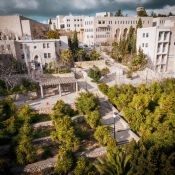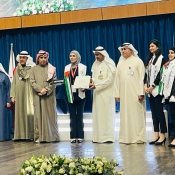Lecture Explores “The Brain’s Internal Map of Space”
Birzeit University’s Faculty of Science held a January 14, 2014 lecture entitled “The Brain’s Internal Map of Space.” The talk, delivered by Nenitha Dagslott, Ingvild Kruge and Charlotte Alme from the Norwegian University of Science and Technology in Trondheim, Norway focused on how researchers can understand higher brain functions, like memory, by studying the neural substrate of one’s “sense” of space.
According to the presenters, much of what we know about memory today can be traced back to a patient named H.M.. As a result of life-threatening epilepsy, H.M. underwent bilateral resection of parts of the medial temporal lobes, including the hippocampus. An unexpected side effect of this surgery was a loss of the ability to form new long-term memories. Research has shown not only how the hippocampus – the core area removed in the surgery – contributes to memory but also how this brain area is strongly involved in mapping of the local environment, suggesting a tight coupling between personal memory and space.
The presenters showed that the animal´s position in the environment is mapped by two types of brain cells – “place cells” in the hippocampus and “grid cells” in the medial entorhinal cortex. There has been much focus on grid cells, which were discovered in the Norwegian lab in 2005. These cells fire at positions that collectively form a regular hexagonal pattern, much like the grid lines of a geometric map, or the cross-points of graphics paper. The spatially periodic activity pattern defines distances as well as directions, serving like an internal coordinate system that may help humans find their way. Signals from grid cells form the basis for computation of place signals in the hippocampus and they may form a basis for episodic memory.
By searching for the neural codes underlying the formation of neural maps of space, the research team hopes to extract some of the general principles for information processing in complex neural systems. Knowledge about the neural circuitry for space and memory will have implications not only for people suffering from neurodegenerative diseases, like Alzheimer’s, where one of the first symptoms is loss of the “sense” of space, but also for neurology and psychiatry more broadly.






